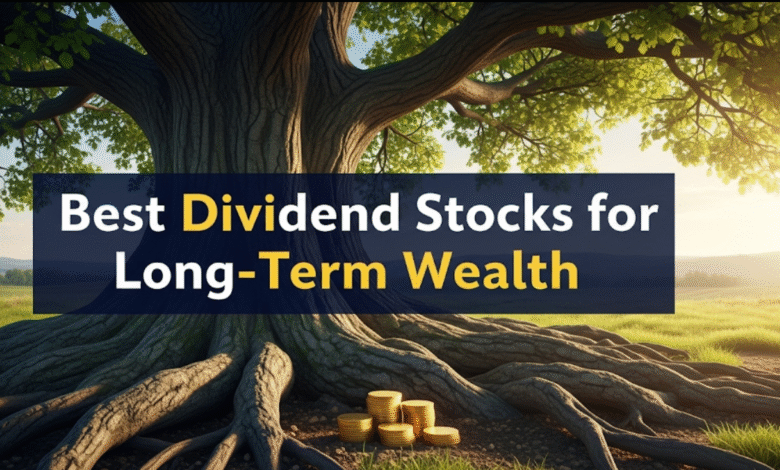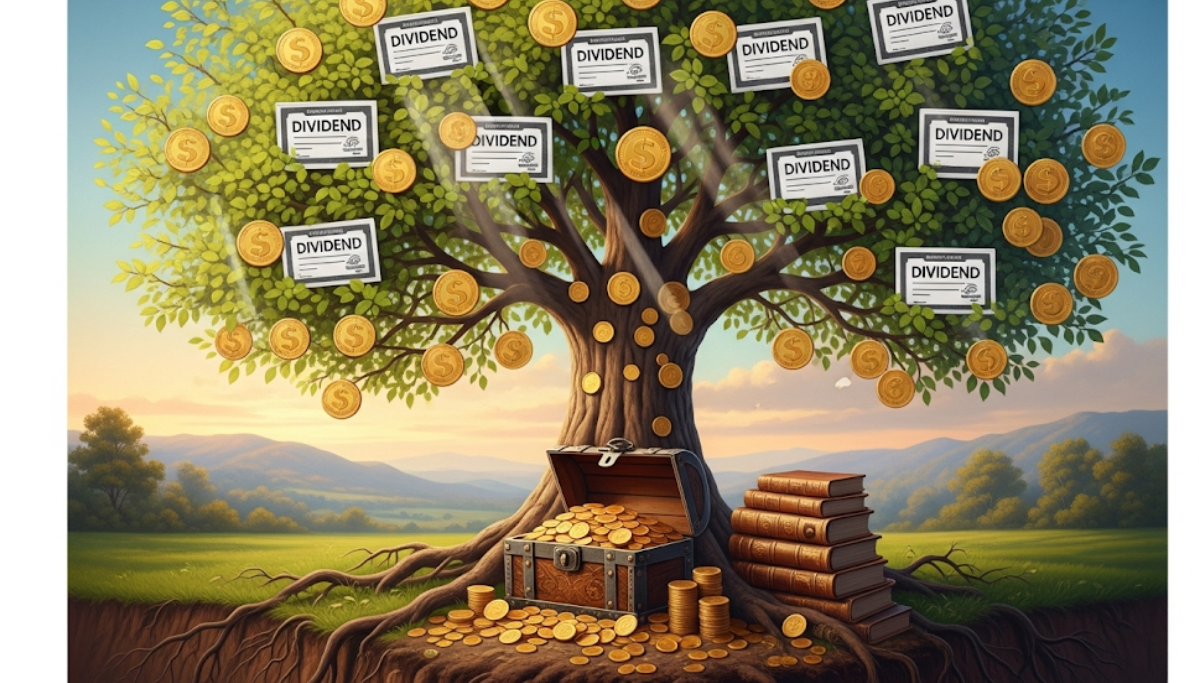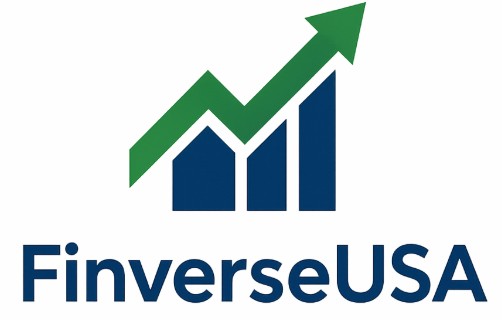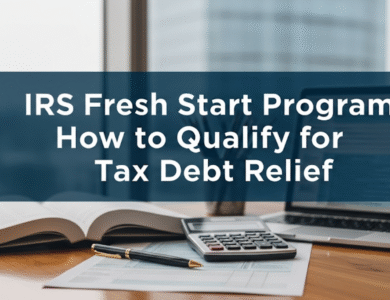
Millions of people have built wealth through dividend investing by creating powerful passive income streams that last for decades. Lots of investors chase the fast buck in growth stocks, but now as ever smart money knows that dividend-paying companies yield the best of all worlds — steady, taxable income plus the chance to see shares appreciate in the years ahead.
If your goal is to generate long-term wealth and live off dividends in retirement, it makes sense to include dividend-paying stocks in your portfolio. These companies pay out a portion of their earnings to shareholders on a regular basis, creating a dependable income stream that can grow into real money over time.
This guide will teach you how to select the best dividend stocks that’ll assist you in your long term wealth creation journey and strategies to help you create Financial Freedom through Dividend Investing.
How Dividend Stocks Build Wealth The Good Old Way
First, dividend stocks are not like other growth stocks. Rather than gambling your shares will become more valuable, dividend companies pay you actual money every quarter for just owning their stock.
That’s the power of dividend investing, and here’s why:
Compound Growth Magic: Because when you reinvest your dividend payouts to buy more shares then those new shares also pay dividends. Over 20-30 years, this compounding can turn meager investments into a lot of money.
Income in Market Crashes: Even if growth stocks may drop 50% or more during bear markets, businesses built to pay dividends often keep paying you all throughout downturns. And that steady income “helps you sleep better at night.”
Protection Against Inflation: The top dividend companies consistently raise their payouts. And as things tend to get more expensive, so, too, does your dividend income, inflating naturally with the cost of living.
Double Profit Potential: You make money in two ways, getting paid dividends along with the stock price rising over time. Then again, this double return source frequently outpaces pure growth investing over the long term.
Top Dividend Stocks – 5 Dividend Sectors for Successful Wealth Building
Consumer Staples Giants
These are businesses that sell people things they need whenever they need it, regardless of the economy — food, household goods, personal care and beverages.
Why They Work: People buy toothpaste, soap and groceries in recessions as well as in booms. That steady demand keeps profits and dividends flowing even in the tough times for other businesses.
Key Players: Procter & Gamble is one of the companies where the dividend has been increased for more than 65 years. Coca-Cola has also paid and increased their dividend every year for 60+ years. These are not sexy growth stories, but they are wealth-generating machines.
Utility Powerhouses
They are monopolies in their respective service areas and provide services that are essential with rate-regulated monopolies for gas, electric and water companies.
People always need electricity and water. Utilities tend to work on long-term utility contracts with steady cash flows, so dividend payments are generally very reliable.
Income Focus: Many utilities generate 4-6% a year, well above the average of around 2% for the stock market. When it comes to earning current income, utilities can be tough to beat for investors.
Financial Sector Leaders
Banks, insurance companies and other financial firms have historically been great dividend payers when they were managed conservatively.
Why Banks Pay Dividends: Banks earn money on the spread between what they pay savers and what they charge borrowers. When well-operated, it can deliver consistent cash flow which can be used to expand dividend disbursements.
Insurance Advantage: Insurance companies take your premiums in advance and pay your claims later. That enables them to generate pools of money to invest, which then help pay the dividends.
Technology Dividend Pioneers
Despite how most tech companies emphasize growth, there are mature technology companies that have started paying hefty dividends as their growth has slowed.
A New Wave: Microsoft and Apple and Intel now pay meaningful dividends even as they continue to grow. This connects you to innovation in technology plus regular income.
Top Dividend Stocks to Consider
| Company | Ticker | Dividend Yield | Years of Increases | Sector |
|---|---|---|---|---|
| Johnson & Johnson | JNJ | 2.8% | 60+ | Healthcare |
| Coca-Cola | KO | 3.1% | 60+ | Consumer Staples |
| Procter & Gamble | PG | 2.4% | 65+ | Consumer Staples |
| Microsoft | MSFT | 0.7% | 20+ | Technology |
| Realty Income | O | 5.2% | 25+ | REITs |
| NextEra Energy | NEE | 2.7% | 25+ | Utilities |
Source: FactSet Always do your own research and only rely on current information to make investment decisions.
Healthcare Heroes
Healthcare firms enjoy growth from aging populations and continued demand for health-related products and services.
Johnson & Johnson: This health care giant produces everything from Band-Aids to cancer medications. J&J is engaged in pharmaceuticals, medical devices and consumer products, providing it with very predictable cash flows which enable it to continue to grow the dividend.
Dividend Track Record: J&J is a “Dividend King” (one of the most elite class of dividend-paying companies in the world), having raised its dividend for over 60 straight years.
Real Estate Investment Trusts (REITs)
REITs possess income-producing real estate and are required by law to distribute at least 90% of profits as dividends.
Realty Income Corporation (O): Dubbed the “The Monthly Dividend Company,” Realty Income distributes its dividends in monthly installments rather than quarterly. They own more than 11,000 properties that lease to stable tenants such as Walgreens, FedEx and 7-Eleven.
Monthly Income Appeal: Receiving dividend payments 12 times a year instead of 4 can facilitate budgeting and provide more opportunities for compounding.
How to Choose Winning Dividend Stocks
The Dividend Safety Check
All dividend stocks are not created equal. Some businesses offer unsustainably high dividends that are slashed during tough times, annihilating both your income and the value of your portfolio.
Payout Ratio: Companies should be paying 60% or less of its earnings as dividends. This leaves a lot of room to grow dividends, and a margin of safety in more difficult times.
Free Cash Flow: Corporations must be producing ample free cash flow to compensate dividends. Free cash flow is the money left over in the till after a company has paid all business expenses and invested in its business.
Levels of debt: High debt can lead companies to reduce dividends during downturns. Search for companies with debt loads that are manageable in comparison with their assets and earnings.
Growth Potential Matters
The best dividend stocks don’t just pay you today; they increase those payments over time.
Dividend Growth Rate: Target companies that have raised their dividends between 5% and 10% each year over a 10 year time frame. This is evidence that management is trying to be rewarding to shareholders.
Business Moats: Seek businesses with competitive advantages defending their position. Strong brands, patents, network effects or high switching costs preserve pricing power and profit margins.
Market Position: Firms that have dominant positions in their markets usually have more consistent cash flows and are better able to raise prices in line with inflation.
Smart Dividend Investing Strategies
Dollar-Cost Averaging Into Dividend Stocks
Rather than attempting to time the market, put the same amount in dividend stocks every month, no matter what share prices are.
Why It Works: You purchase more shares when prices are low and fewer when prices are high. Eventually, as you participate in the dollar-cost-averaging process, your average cost basis drops, and you end up owning more dividend-paying shares.
Automation Benefit: Automate the investing process to eliminate emotion from the equation. Most brokers now also offer fractional shares, making it possible to invest in increments of 1 cent in costly dividend-paying stocks.
Dividend Reinvestment Programs (DRIPs)
There are also many companies and brokers who provide programs that automatically reinvest your dividend payments to buy more shares.
Compound Power: Each dividend received can be used to buy additional shares, which in turn generate additional dividends, compounding the wealth building.
Cost Benefits: They let you reinvest the money (often commission free) marginally, if at all, below market price, so your money grows more rapidly.
Sector Diversification
A few words of wisdom for dividend investors: Don’t put all your eggs in one basket. Diversify your investments, making them in several different sectors.
Economic Cycle Coverage: Some sectors shine at certain times. Some utilities could flounder in an era of low interest rates while financials thrived and vice versa.
Risk Management: If your one sector is in trouble, your other dividend stocks can still add an income until that sector recovers.
Building Your Dividend Portfolio
The Three-Bucket Approach
Bucket your dividend investments into three segments, in accordance with your life stage and income requirement.
Growth Bucket (40-50%): Younger investors and/or those who do not need current income will want to focus on dividend growth stocks with lower current yields but better growth potential.
Balanced Bucket (30-40%): Mix of moderate-yield stocks with published fixed income growth. These will have good current income while continuing to grow over time.
Income Bucket (10-20%): For those needing more current income, higher yield stocks such as REITs and utilities. But these tend to grow more slowly and generate cash flow right off the bat.

Sample Portfolio Allocation
For a $100,000 dividend portfolio:
- $45,000 Growth Focus: Technology dividend payers, healthcare disruptors, growing consumer brands
- $35,000 Balanced Mix: Quality, established consumer staples, diversified REITs, quality financials
- $20,000 Income Focus: Utilities, high-yield REITs, dividend-focused ETFs
Portfolio Monitoring and Rebalancing
Check on your dividend portfolio every quarter but don’t trade so much with it because of market turmoil.
What to Watch: Look for dividend coverage ratios, company earnings and announcements of changes to dividend policy.
Rebalancing Timing: Sell positions that have become too large, and add to areas of the market that are underweighted, once or twice a year. This disciplined approach ensures you stay to your desired allocation and makes you to sell high and buy low.
Common Dividend Investing Mistakes
Chasing High Yields
The highest-yielders are often at the highest risk of a dividend cut. An 8 percent dividend yield may seem attractive, but if the company cuts the dividend by 50 percent, you’ve lost both income and share value.
Red Flag Yields: Be wary of yields higher than 6-7% unless they’re for REITs or utilities. It’s often the case that extremely high yields suggest financial distress.
Ignoring Company Fundamentals
Some people go with just dividend yield and don’t look at the quality of the business.
See Beyond the Yield: A 3% yielder that grows its dividend at 10% per year at some point produces more income than a 6% yielder with no growth.
Poor Tax Planning
Just be sure to plant your accounts in the right place, because dividend taxes can eat into your returns.
Tax-Advantaged Accounts: Hold any dividend stocks in IRAs and 401(k)s if you can to not pay annual taxes on dividends at all.
Tax-Efficient Taxable Accounts: For standard taxable investment accounts, aim for qualified dividends, which receive preferential tax treatment.
Advanced Dividend Strategies
Dividend Capture Strategy
Some investors attempt to purchase shares right before the date of a dividend payment and sell soon after, in order to collect the dividend.
Why It Often Doesn’t Work: Stock prices tend to fall by the amount of the dividend on the ex-dividend date, eliminating most of the gain. Besides, you will owe taxes on the dividend and receive none of the long-term holding period benefits.
International Dividend Opportunities
Don’t confine yourself to U.S. dividend stocks. Several foreign stocks have appealing dividend yields and growth opportunities.
Geographic Diversification: Foreign dividend stocks help in diversifying currency and accessing other economic cycles.
Tax Implications: There may be some extra tax hassles with foreign dividends—talk to a tax pro before going all-in on foreign dividend stocks.
The Long-Term Wealth Building Timeline
Years 1-5: Foundation Building
Concentrate on building your habit of investing in dividends and constructing your diversified portfolio of quality dividend stocks.
Results: Dividends from a $100K Investment Your portfolio could throw off $2,000-5,000 a year in dividends if you make a $100,000 investment, assuming average yields of 2-5%.
Years 6-15: Acceleration Phase
You have not yet made a fortune — both dividend reinvestment and monthly contributions begin accelerating the creation of wealth.
Compound Power: Your dividends buy more shares that, in turn, give you more in dividends. This effect snowballs even more.
Years 16-30: Wealth Realization
Years of dividend growth and reinvestment make up hefty passive-income streams.
Financial Independence: A lot of investors eventually become dividenders when the dividend income covers a considerable amount of the expenses; this is real freedom in terms of personal finance.
Frequently Asked Questions
How much do you have to invest to start investing in dividends?
Through fractional share investing, which many brokers offer, you can even get started with dividend investing for as little as $100. But $1,000-5,000 does give you enough cash to diversify across several different dividend stocks.
How much can I expect to make from dividend stocks?
The returns of dividend stocks over the long-term have been found to have an average annual return of between 8% to 10%, which is inclusive of the dividends being returned and the price of the share appreciating. But the returns can fluctuate dramatically from year to year.
Is it better to concentrate on high-yield or dividend growth stocks?
It depends on your situation. If you need income, higher-yielding stocks make sense. For longer-term wealth building, it’s frequently the case that dividend growth stocks result in higher total returns over 20+ year periods.
How often should I monitor my dividend portfolio?
Keep an eye on your holdings every quarter when companies report their earnings, but avoid tinkering too frequently. Dividend investing is about patience, not quick riches.
Can I invest in dividend stocks and still be safe in recessions?
Dividend-paying stocks of good quality tend to fare better than growth stocks during recessions, but no investment is completely immune to a downturn. Some firms will reduce dividends in times of extreme stress, although the best dividend payers tend to keep paying or swiftly re-establish the payout.
What’s the difference between dividend yield and total return?
Dividend yield is the annual dividend payment by the share price. Total return is the sum of dividend payments and any change in stock price.
How are dividends taxed?
In simpler terms, most qualified dividends from U.S. companies are taxed at favorable long-term capital gains tax rates (which can be 0%, 15%, or 20% depending on your income). Non-qualified dividends are taxed at ordinary income rates.
Is it possible to live just off of dividend income?
A “yes,” but it takes a lot of money. You’d need anywhere from, say, $1-2 million invested in dividend-paying stocks at assumed average yields, to create $50,000 in dividends generated every single year.
Today is the First Day of Your New Dividend Journey!
Creating long-term wealth with dividend stocks is not difficult, but it requires patience and discipline. The firms featured in this guide boast a track record of earnings growth and shareholder returns through tumultuous economic conditions, time and again.
Begin with high-quality dividend-paying stocks from a variety of sectors, reinvest your dividend payments, and inject new money regularly. Compound growth and time will do the hard work for you, and small monthly amounts can grow to be life-changing amounts of passive income.
The rich didn’t become wealthy by following recent market trends or timing ideal entry points. They put money into companies that made money for them in order to own them, and they stuck with those investments for decades, reinvesting the profits.
Here’s the thing: Your dividend investment journey starts with the very first share you purchase. Pick great companies and execute these principles, and watch how time and compound growth can create the financial freedom you deserve. The best time to plant a dividend tree was 20 years ago, second best time is today.

